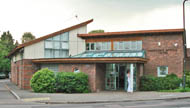Roxbourne Hospital
41 Rayners Lane, South Harrow, Middlesex HA2 0HE
Medical dates:
Medical character:
Infectious diseases. Later, geriatric
The Harrow Isolation Hospital,
built and financed by the surrounding Urban District Councils in 1895, opened
in 1896 for the "reception of cases of scarlet fever, diphtheria,
enteric fever and Asiatic cholera". It had 10 beds.
In 1905 a new Scarlet Fever Block was built at a cost of £1,900. It contained one ward with 6 beds and one with 4, doubling the bed capacity of the old Scarlet Fever Block, which was afterwards used for diphtheria patients. The bed complement of the Hospital was increased to 15.
The administration block was enlarged. The ground floor contained offices, the kitchen, scullery, larder, sitting rooms for the Matron, the nurses, the porter and the cook, as well as washrooms and a coal house. On the first floor were 6 bedrooms, a bathroom, WC and lavatory, with a new hot and cold water supply.
The ambulance block was also enlarged, so that there was room for two disinfection carts as well as the two ambulances. The Hospital also had a Thresh disinfector.
The cost of the works totalled £2,750.
Visits to patients were strictly controlled. Only in special circumstances and sanctioned by the Medical Officer or Sanitary Inspector, could visitors enter the ward. Visits were only possible on two afternoons a week and could last no longer than 15 minutes. Patients who were well enough to be on a full diet received 4 ounces of suet pudding three times a week.
In 1936 the Public Health Committee of Harrow Council resolved to replace the gas lighting with electric lighting in the room where operations were carried out. It was decided that, in view of the anticipated closure of the Hospital when a new isolation hospital was built, it was not necessary to modernise the rest of the buildings.
By 1946 the Hospital had 25 beds.
It joined the NHS in 1948 under the control of the Hendon Group Hospital Management Committee, part of the North West Metropolitan Regional Hospital Board. The buildings were modernised and it was renamed the Roxbourne Hospital. It had 50 beds for the elderly chronic sick and was linked with Edgware General Hospital.
In 1969 the Hospital became part of the Geriatric Unit at the newly built Northwick Park Hospital. Patients were first admitted to the 25-bed ward at Northwick Park Hospital for investigation and treatment. About half were then transferred to Harrow Hospital for continuation of treatment and rehabilitation, while those needing long-term care were transferred to Roxbourne Hospital.
The Hospital closed in 1993, with 51 beds.
In 1905 a new Scarlet Fever Block was built at a cost of £1,900. It contained one ward with 6 beds and one with 4, doubling the bed capacity of the old Scarlet Fever Block, which was afterwards used for diphtheria patients. The bed complement of the Hospital was increased to 15.
The administration block was enlarged. The ground floor contained offices, the kitchen, scullery, larder, sitting rooms for the Matron, the nurses, the porter and the cook, as well as washrooms and a coal house. On the first floor were 6 bedrooms, a bathroom, WC and lavatory, with a new hot and cold water supply.
The ambulance block was also enlarged, so that there was room for two disinfection carts as well as the two ambulances. The Hospital also had a Thresh disinfector.
The cost of the works totalled £2,750.
Visits to patients were strictly controlled. Only in special circumstances and sanctioned by the Medical Officer or Sanitary Inspector, could visitors enter the ward. Visits were only possible on two afternoons a week and could last no longer than 15 minutes. Patients who were well enough to be on a full diet received 4 ounces of suet pudding three times a week.
In 1936 the Public Health Committee of Harrow Council resolved to replace the gas lighting with electric lighting in the room where operations were carried out. It was decided that, in view of the anticipated closure of the Hospital when a new isolation hospital was built, it was not necessary to modernise the rest of the buildings.
By 1946 the Hospital had 25 beds.
It joined the NHS in 1948 under the control of the Hendon Group Hospital Management Committee, part of the North West Metropolitan Regional Hospital Board. The buildings were modernised and it was renamed the Roxbourne Hospital. It had 50 beds for the elderly chronic sick and was linked with Edgware General Hospital.
In 1969 the Hospital became part of the Geriatric Unit at the newly built Northwick Park Hospital. Patients were first admitted to the 25-bed ward at Northwick Park Hospital for investigation and treatment. About half were then transferred to Harrow Hospital for continuation of treatment and rehabilitation, while those needing long-term care were transferred to Roxbourne Hospital.
The Hospital closed in 1993, with 51 beds.
Present status (May 2008)
The Hospital has been demolished and the site now contains the Roxbourne Complex, a mental health care facility with two 14-bedded units, run by the Central and North West London NHS Foundation Trust, and, at the south corner, the Roxbourne Medical Centre.

The Roxbourne Complex.


The Roxbourne Medical Centre.
Glossop ES 1991 Roxbourne Hospital. In: Denham MJ Care of the Long-Stay Elderly Patient, 2nd edn. Dordrecht, Springer-Science+Business Media, BV, 265-274.
Hodkinson HM, Jefferys PM 1972 Making hospital geriatrics work. British Medical Journal 4 (5839), 536-539.
Little JF 1906 Annual Report of the Medical Officer of Health. Harrow-on-the-Hill Urban District Council, 8-13.
Thomas C 1948 Report of the Medical Officer of Health. Urban District of Harrow, 12.
Thomas C 1949 Report of the Medical Officer of Health. Urban District of Harrow, 15.
Thomas C 1954 Report of the Medical Officer of Health. Borough of Harrow, 22-23.
Walter D 1995 A Lookback at Harrow. Harrow, Orpheus Publications.
http://hansard.millbanksystems.com
https://southharrowthenandnow.co.uk
www.british-history.ac.uk
www.harrow.gov.uk (1)
www.harrow.gov.uk (2)
www.harrow.gov.uk (3)
Return to home page